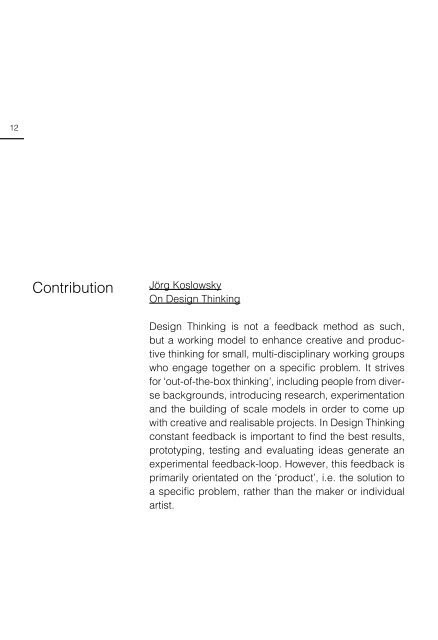Laboratory on Feedback in Artistic Processes 1
Feed-back is everywhere, and as a means to reflect, gather and share resources and methods on this expanding field the “Laboratory on Feedback in Artistic Processes” was initiated within the frame of “Teachback” – one of the modules of the project “Life Long Burning” 1 in collaboration with HZT Berlin and Uferstudios Berlin. The lab, held in January 2014, invited a group of people who shared an interest in the topic of feedback. Over the three days the group practiced, articulated and discussed different approaches, aims and experiences of existing methods of feedback. The idea was that a number of feedback-methods should be applied and tried out within the lab, as opposed to merely remaining on a theoretical discursive level. The document functions as a summarized report on the feedback lab; it collates the remarks from the invited observers, who were Inge Koks and Frederik Le Roy. Through a chronological order the document mainly gives a brief summary on each participant’s contribution with additional considerations and reflections on the proposed method or presentation. This short paper is written firstly as a documentation for those who partook in the lab and secondly, as a reference for those who will participate in a follow up format about feedback. IMPRINT Text by Sheena McGrandles, Nik Haffner, Inge Koks, Frederik Le Roy Photos, Layout and Editing Sheena McGrandles Editor: HZT Berlin, 2014
Feed-back is everywhere, and as a means to reflect, gather and share resources and methods on this expanding field the “Laboratory on Feedback in Artistic Processes” was initiated within the frame of “Teachback” – one of the modules of the project “Life Long Burning” 1 in collaboration with HZT Berlin and Uferstudios Berlin.
The lab, held in January 2014, invited a group of people who shared an interest in the topic of feedback. Over the three days the group practiced, articulated and discussed different approaches, aims and experiences of existing methods of feedback. The idea was that a number of feedback-methods should be applied and tried out within the lab, as opposed to merely remaining on a theoretical discursive level.
The document functions as a summarized report on the feedback lab; it collates the remarks from the invited observers, who were Inge Koks and Frederik Le Roy. Through a chronological order the document mainly gives a brief summary on each participant’s contribution with additional considerations and reflections on the proposed method or presentation. This short paper is written firstly as a documentation for those who partook in the lab and secondly, as a reference for those who will participate in a follow up format about feedback.
IMPRINT
Text by Sheena McGrandles, Nik Haffner, Inge Koks, Frederik Le Roy
Photos, Layout and Editing Sheena McGrandles
Editor: HZT Berlin, 2014
Create successful ePaper yourself
Turn your PDF publications into a flip-book with our unique Google optimized e-Paper software.
Additi<strong>on</strong>al<br />
c<strong>on</strong>siderati<strong>on</strong>s<br />
and reflecti<strong>on</strong>s<br />
• A diversity of backgrounds <strong>in</strong> the group is an advantageous<br />
element.<br />
• The c<strong>on</strong>stellati<strong>on</strong> of a group (and pers<strong>on</strong>alities) is<br />
important.<br />
• Collective processes can be stimulat<strong>in</strong>g but also<br />
time c<strong>on</strong>sum<strong>in</strong>g and therefore irritat<strong>in</strong>g.<br />
12 • The <strong>in</strong>itial questi<strong>on</strong> is of great importance to the process.<br />
13<br />
References<br />
Design Th<strong>in</strong>k<strong>in</strong>g: www.design-th<strong>in</strong>k<strong>in</strong>g.org<br />
D-Colletive: www.facebook.com/d.collective.space<br />
C<strong>on</strong>tributi<strong>on</strong><br />
Jörg Koslowsky<br />
On Design Th<strong>in</strong>k<strong>in</strong>g<br />
Design Th<strong>in</strong>k<strong>in</strong>g is not a feedback method as such,<br />
but a work<strong>in</strong>g model to enhance creative and productive<br />
th<strong>in</strong>k<strong>in</strong>g for small, multi-discipl<strong>in</strong>ary work<strong>in</strong>g groups<br />
who engage together <strong>on</strong> a specific problem. It strives<br />
for ‘out-of-the-box th<strong>in</strong>k<strong>in</strong>g’, <strong>in</strong>clud<strong>in</strong>g people from diverse<br />
backgrounds, <strong>in</strong>troduc<strong>in</strong>g research, experimentati<strong>on</strong><br />
and the build<strong>in</strong>g of scale models <strong>in</strong> order to come up<br />
with creative and realisable projects. In Design Th<strong>in</strong>k<strong>in</strong>g<br />
c<strong>on</strong>stant feedback is important to f<strong>in</strong>d the best results,<br />
prototyp<strong>in</strong>g, test<strong>in</strong>g and evaluat<strong>in</strong>g ideas generate an<br />
experimental feedback-loop. However, this feedback is<br />
primarily orientated <strong>on</strong> the ‘product’, i.e. the soluti<strong>on</strong> to<br />
a specific problem, rather than the maker or <strong>in</strong>dividual<br />
artist.


















